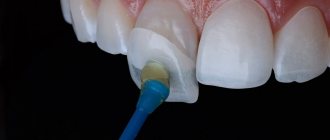Indications for surgery
Today, dentists prefer tooth-preserving operations. Therefore, even if there is only one root left, they first study whether it can be used as a basis for future prosthetics. However, in medical practice there are often situations when the removal of a decayed tooth must be carried out without fail.
This is possible if:
the tooth base has become very loose due to advanced periodontitis;- fracture diagnosed;
- a cyst has been discovered that cannot be removed in isolation;
- a fragment of the crown that extends deep under the gum has broken off;
- a part remained after the unit was carelessly removed.
Milk units should ideally fall out on their own. They are pulled out when the coronal part is completely damaged by caries, loosened or fractured, or a carious process that has spread under the gum.
When is it necessary to remove a tooth root?
In all cases, the doctor decides individually whether the situation requires tooth root removal after carrying out diagnostic measures and examination using radiography or visiography. Among the most common indications for tooth root removal are the following:
- the patient suffers from aching and throbbing pain in the tooth;
- in the peri-root area there is some swelling of the gums;
- there are signs of inflammation;
- the root of the tooth is destroyed;
- third degree of tooth root mobility;
- tooth fracture is of increased complexity;
- the level at which the destruction of the dental crown is located is located below the level of the gums;
- a cyst was diagnosed.
If the rotting tooth root is not removed in a timely manner, it can give rise to a serious infectious process in the oral cavity, as well as bad breath. Problems will certainly affect healthy tissues nearby.
In some cases, even in the presence of inflammation and severe tooth decay, you can do without root removal. This will allow, after carrying out the necessary therapeutic measures, to restore or build up the tooth. The final decision on this issue is made by the dentist.
Can the root “come out” on its own?
Fearing surgical removal of the tooth root and the associated discomfort, some hope that the dental fragments will leave the gums on their own. Such people walk around for years with bone remains decomposing in their mouths, which are breeding grounds for infections and contribute to the appearance of an unpleasant odor. The root can actually come out on its own, but this rarely happens.
More frequent scenarios:
- deposition of a large amount of hard plaque on it and irritation of the soft surrounding tissues;
- overgrowth of the gums and the appearance of an acute inflammatory process (subsequently, surgery has to be performed to solve this problem).
Sometimes a rotten maxillary root causes an infection that spreads directly to the maxillary sinuses. If it is in the bottom row, the patient may encounter osteomyelitis - a purulent-necrotic process that develops in the bone.
Possible reasons
An experienced doctor will always make sure that the unit is completely removed. If the case was complex, additional radiography may be performed. There are several reasons why this complication can occur:
- Removal of a complex tooth when an adjacent unit is accidentally affected during the operation. This usually leads to the destruction of the adjacent tooth, and a small fragment ends up in the injured socket.
- Unsatisfactory condition of the tooth root. When removed, pieces of the root may break off, especially if it is susceptible to rotting.
- Often, a splinter remains in the tooth due to incorrect movements while removing the tooth from the socket.
Symptoms indicating that part of the tooth root remains after extraction
Normally, after surgery to remove the affected unit, nothing should remain in the gum. But, if the doctor acted illiterately, in the future it may turn out that individual particles of hard tissue were still preserved in the gums.
The patient can understand that not everything is in order based on a number of specific symptoms:
even after several weeks the throbbing pain persists;- the surrounding tissues are swollen, inflamed, red;
- body temperature rises from time to time;
- The postoperative wound heals slowly and often bleeds.
If these signs appear, you need to make an appointment with a good dentist as soon as possible. He will take a picture and check for complications.
Pain after wisdom tooth removal - what is the reason and what to do?
Pain after wisdom tooth removal will be especially painful if the patient develops inflammatory complications. The most common are alveolitis, periostitis, osteomyelitis.
Causes of complications:
- leaving bone fragments of the tooth in the wound;
- wound infection during manipulation;
- tooth extraction due to tonsillitis, glossitis, etc.;
- overheating of bone tissue by the tip of the drill;
- there are no stitches on the wound;
- The doctor's prescriptions for taking antibiotics have not been followed.
Infectious safety of the patient is one of the strictest rules strictly observed by the staff of the Khoroshevskaya clinic. The processing of equipment and consumables is carefully controlled with multiple checks with special indicators for the absence of pathogenic flora. Everything that can be disposable is disposable. The remaining instruments are sterilized in accordance with state safety standards in a multi-stage process with guaranteed confirmation of sterility.
Alveolitis
Alveolitis is an inflammation of the socket, one of the most common complications and the cause of severe pain after the removal of wisdom teeth. The clinical picture of alveolitis is accompanied by severe wound pain, the hole is covered with a dirty gray coating, and pus is released. There is an unpleasant taste and smell in the mouth. Pain caused by alveolitis persists for 3-4 weeks and disappears after the inflammatory process subsides.
Periostitis
Periostitis is a purulent inflammation of the periosteum that can occur independently, but more often progresses after alveolitis is left unattended. It develops for the same reasons as inflammation of the socket. The clinic of periostitis cannot be ignored - the pain is diffuse, acute, the pills help only slightly. The lower part of the face swells quite severely, the swelling can even spread to the neck. There is an increase in temperature above 38 degrees, and the general condition worsens. If this complication is not treated, osteomyelitis, abscess, and phlegmon may develop.
Osteomyelitis
Simple wisdom tooth removal is rarely accompanied by noticeable swelling. Most often, swelling appears if the patient has significant subcutaneous fat, it occurs a few hours after visiting the doctor, and goes away within 2-3 days. The location of the swelling also depends on the location of the extracted tooth. If the “eight” was removed from the upper jaw, the likelihood of swelling increases even with simple removal, because The blood supply in this area is abundant, the vascular network is dense. With complex tooth extraction (especially when cutting it into pieces), swelling is almost inevitable. During the first few days it interferes with normal eating and mouth opening, then it subsides. If, 2 days after the removal of a wisdom tooth, the gums hurt and the swelling does not decrease, there may be suppuration. You need to contact your dentist for an examination to determine the cause of the problem.
How to pull out the remaining root in the gum
It is always easier for a dental surgeon to remove the entire tooth than just the remaining root parts.
First, the doctor carries out diagnostic measures, which include:
inspection;- reorganization;
- taking pictures.
If he deems it necessary, he may ask the client to take a blood test. On the appointed day, the patient is given an anesthetic. Local anesthesia is usually sufficient. When the anesthetic takes effect, the hard fragments are removed using special forceps. When the gums are completely overgrown, they are first excised, and the bone tissue is drilled out to gain access to the root zone. After this, using a dental elevator, all detected particles of the missing unit are removed. Such an operation is certainly complex and traumatic. Upon completion, stitches are applied.
Methods for restoring a lost front tooth
If a front tooth has fallen out or been removed, then aesthetics is a very important aspect. The front teeth are a smile, this is a person’s appearance. The absence of a tooth in such an aesthetically important area significantly reduces a person’s quality of life. There may be several treatment options here.
Method 1: implant installation
It’s worth saying right away that installing an implant in the area of a missing tooth will be the most reasonable and least traumatic solution to the problem. Installing an implant involves implanting a titanium tooth root into the bone and then installing a crown on it. This design has a long service life, does not affect neighboring teeth and ensures complete restoration of the function and aesthetic properties of the teeth.
Method 2: installation of a bridge
Other options for restoring a tooth lost due to various reasons may be orthopedic methods, which are bridges and removable dentures. The most important and rather significant disadvantage of bridges in the oral cavity is its traumatic nature in relation to neighboring teeth. To make a bridge structure, the doctor needs to determine the supports on which the prosthesis will be fixed. There can be 2 such supports (2 teeth on each side of the missing one) or even more. In accordance with this, each supporting tooth must be processed and prepared for a crown, which will be part of the prosthesis. In some cases, the choice of several supports (more than 2) depends on the condition of the teeth, the area of the fallen or extracted tooth and the number of missing teeth. In addition, the disadvantage of bridges is the possible deterioration of the condition of the supporting teeth after the expiration of the service life of the prosthesis. If it is necessary to replace it, the supporting teeth, as a rule, do not satisfy all the necessary requirements, as a result of which it is necessary to take more teeth as supporting teeth or change the treatment method.
Method 3: installation of a removable denture
Another treatment option is a removable denture, which replaces the missing tooth. Such a prosthesis also needs support, not with the help of crowns, but with the help of special clasps (hooks that cling to adjacent teeth). In addition to the low aesthetic properties of this prosthesis, wearing it over time causes atrophy of bone tissue in the area of the removed or fallen tooth, which can create certain difficulties if it is necessary to change the design.
Method 4: installation of pin structures and inlays
Another method of orthopedic dentistry is pin structures and inlays. These are special metal structures, on one side they have a pin that is fixed in the root of the tooth, on the other side there is a stump of the prepared tooth, and the crown is fixed on the part. With their help, you can restore a tooth if only the root remains. After treating the root and filling it, a pin-stump inlay is made, which serves as a tooth stump, onto which the crown is subsequently fixed, and the inlay pin strengthens the root and makes the final structure strong. The inlay is not visible under the crown, which gives high aesthetic properties to this treatment method. The inlays have found wide application and are successfully used by many doctors. In this case, the key role is played by the condition of the broken tooth, namely the remaining root. If the root allows the use of an inlay, then such a tooth can last for quite a long time. With such designs, the level of bone tissue is preserved, which allows for implantation after the expiration of the service life of the inlay and crown.
The most optimal way
Based on all of the above methods, in the absence of a tooth, it is better to place dental implants, since this method is the least traumatic, meets functional and aesthetic requirements, has a long service life and maintains the volume of bone tissue at the required level. Implantation is also the most optimal treatment method for complete absence of teeth. In such situations, there are several methods; in any case, implants are the most optimal solution. Several implants can support the load of the entire jaw.
Prosthetics on implants are also variable. Each patient will be able to choose the appropriate option for himself. The hygiene of structures fixed on implants is also very convenient for both the patient and the doctor. Regular visits to the dentist for preventive examinations allow you not only to maintain the proper level of hygiene, but also to monitor the dynamics of the condition of the bone tissue and the condition of the implants in the bone.
Depending on the age of the patient, various types of dental restoration are recommended, we are talking about implantation and removable prosthetics, which can be used in the case of an extremely small volume of jaw bone tissue and the impossibility of installing implants. In such cases, removable dentures are the treatment of choice for the patient. If it is possible to install at least 4 implants, then you should give preference to the surgical method!
Features of wisdom tooth root removal
Eights are rightfully considered the most problematic. They often grow perpendicular to their neighbors and are very difficult to reach. At the same time, their roots go deep and are difficult to pull out. First, the patient undergoes x-ray diagnostics so that the dentist can thoroughly study the features of the location of the unit. After this, a treatment plan is drawn up and followed exactly. If it is immediately clear that tooth root removal will be very difficult, the surgeon may decide to use general anesthesia. Then the patient will sleep throughout the operation, and the doctor will be able to act more freely, without fear of causing him severe pain. It should be noted that general anesthesia is used for dental purposes only in extreme cases. After anesthesia, the patient may experience nausea, vomiting, and headaches. In addition, anesthetic medications have many side effects and negatively affect overall health.
Types of seams and suture materials
The patient’s further actions depend on what materials and suturing technique the surgeon used in dentistry. There are seams:
- Intermittent - stitches are applied separately, each secured with its own knot. Damage to one stitch does not affect the integrity of the others, allowing you to keep the hole closed.
- Continuous - all stitches are made with one suture thread and have a common knot. If one stitch is damaged, the entire seam comes apart.
Features of suture material:
- Absorbable threads are a sterile material of natural or synthetic composition, which after some time disintegrates into independent elements. During the healing process of the hole, the sutures securely fix the wound and then completely dissolve.
- Non-absorbable compounds are common synthetic threads used by dental surgeons in their work. These are polyester, nylon, silk, monofilament.
The material and features of suturing influence how the sutures are removed after the removal of a wisdom tooth or another unit.
Amputation of a part
It is not always necessary to remove the entire root. In certain situations, the doctor may decide to perform an amputation. This operation involves removing only part of the hard tissue located deep in the gum. Their healthy fragments remain intact. The space that remains after removing the elements is filled with a special osteoplastic mass. Due to this, the unit continues to be securely held in the dentition and hardly becomes loose. Amputation is only relevant if the crown is in satisfactory condition. If it is absent, there is no point in such treatment, since a partially preserved root cannot be considered as a durable support for a prosthesis or bridge.











